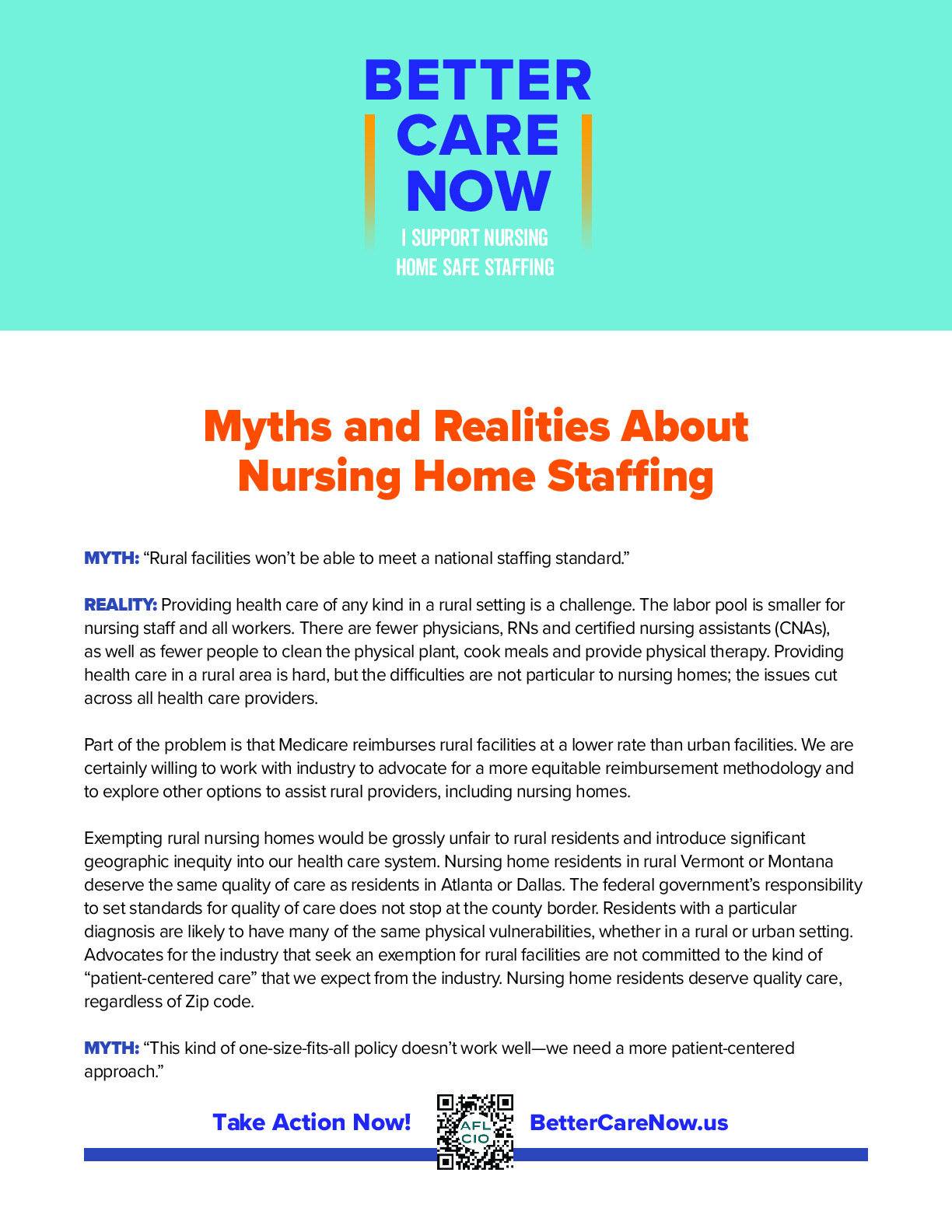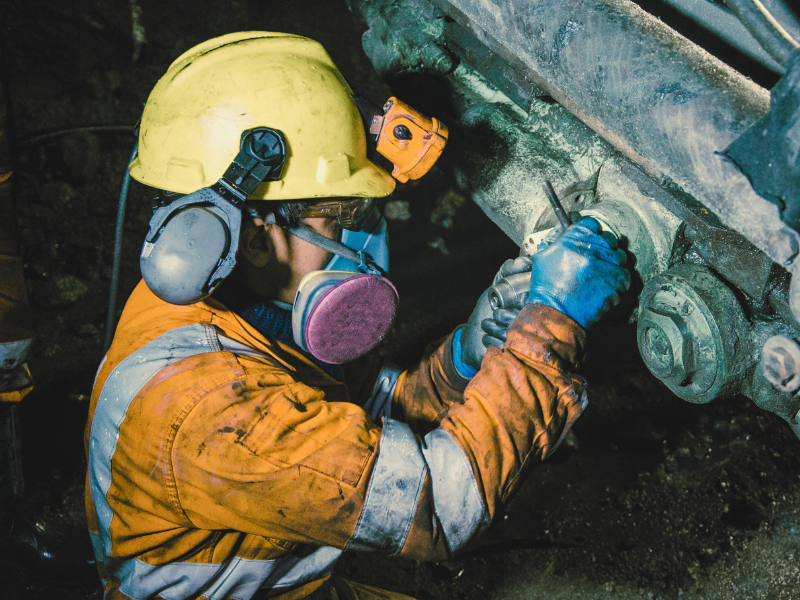MYTH: “Rural facilities won’t be able to meet a national staffing standard.”
REALITY: Providing health care of any kind in a rural setting is a challenge. The labor pool is smaller for nursing staff and all workers. There are fewer physicians, RNs and certified nursing assistants (CNAs), as well as fewer people to clean the physical plant, cook meals and provide physical therapy. Providing health care in a rural area is hard, but the difficulties are not particular to nursing homes; the issues cut across all health care providers.
Part of the problem is that Medicare reimburses rural facilities at a lower rate than urban facilities. We are certainly willing to work with industry to advocate for a more equitable reimbursement methodology and to explore other options to assist rural providers, including nursing homes.
Exempting rural nursing homes would be grossly unfair to rural residents and introduce significant geographic inequity into our health care system. Nursing home residents in rural Vermont or Montana deserve the same quality of care as residents in Atlanta or Dallas. The federal government’s responsibility to set standards for quality of care does not stop at the county border. Residents with a particular diagnosis are likely to have many of the same physical vulnerabilities, whether in a rural or urban setting.
Advocates for the industry that seek an exemption for rural facilities are not committed to the kind of “patient-centered care” that we expect from the industry. Nursing home residents deserve quality care, regardless of Zip code.
MYTH: “This kind of one-size-fits-all policy doesn’t work well—we need a more patient-centered approach.”
REALITY: This staffing standard is a floor, not a ceiling, on how much care a resident must get. Facilities still must provide “sufficient” staffing, which means a facility must provide care that is tailored to the needs of the particular patient. Facilities still must assess residents’ needs and employ nursing staff based on the needs of individual residents.
MYTH: “We want to have greater staffing but can’t hire enough workers.”
REALITY: We don’t have a shortage of workers, we have a shortage of good-paying jobs. The median annual income for CNAs who provide most of the hands-on care is around $24,200. Approximately 12% of these workers live in poverty, and 41% live in what could be considered low-income households. Among Black and Hispanic female direct care workers, about 50% earn less than $15 per hour.
In addition to low wages, direct care workers also face difficult and dangerous working conditions. Among the major concerns cited by workers are chronic understaffing, workplace violence, undue risk of injury or illness, chronic fatigue, mental health strain, and the moral injury that results from not having the support and resources to provide the quality care nursing staff know they can provide. For decades, unsafe working conditions and poverty-level wages have driven dedicated health care workers away from the bedside. We must improve compensation and working conditions—including giving workers a voice at work—if we are to stabilize and increase the workforce.
MYTH: “There aren’t enough people in the United States that are willing to work in nursing homes. Shouldn’t we focus on immigration reform so more workers can come from overseas?”
REALITY: None of the major concerns of nursing home workers can be fixed through immigration policy. New foreign workers will be exposed to the same hazardous working conditions and disrespect that is creating churn in the workforce. Changes in immigration policy that fail to address wages and working conditions won’t change the difficulty nursing facilities have in hiring nursing staff—only better, safer jobs will do that.
We also should learn from the hospital sector, where, all too often, health care workers from abroad are exploited by staffing agencies. Foreign nurses, for example, often are required to stay at their current employer for up to five years or pay exorbitant contract fees. These agencies also ensure that nurses recruited overseas remain unaware of wage and hour laws or other basic U.S. labor protections. They frequently end up being illegally overworked and under-compensated while contractually bound to their employer.
The hospital model is not one we should replicate, since diminishing working conditions for any one group of workers will set a precedent and lower standards for all, as employers across sectors undoubtedly search out the lowest-cost alternatives.
MYTH: Nursing homes can’t afford to hire more staff. Medicaid doesn’t pay enough to staff facilities at higher rates.
REALITY: The claim that Medicaid rates are too low to allow for higher staffing is not supported by reliable data.
First, Medicaid reimbursement to nursing homes varies widely, and in some states nursing homes report positive margins on Medicaid. For example, the average Medicaid nursing home payment in California in 2020 was more than 90% of the average nursing home payment from Medicare—a program that year after year reimburses at a level that exceeds facility costs and provides double-digit profit margins. In New York, recent litigation revealed millions of dollars of profits that could have gone to staffing if a state law requiring a minimum amount of reimbursement devoted to workers’ compensation had been in effect earlier. There is reason to think many nursing homes can partially finance the costs of additional staffing from internally generated resources.
Second, comparisons with Medicaid are misleading. Though Medicaid covers the majority of nursing home residents, less than one-third of nursing home revenue comes from Medicaid reimbursement and the vast majority of residents—more than 80%—are “dually eligible,” which means their initial care is covered by Medicare. It is true that Medicaid covers the care of long-stay residents, but these people generally have medically less intensive nursing and therapy care needs. Their cost of care is generally lower. Moreover, many state laws granting Medicaid eligibility to residents who “spend down” their own assets require them to pay for a substantial portion of their care out of pocket, which further reduces the relevance of Medicaid rates.
Third, the complete lack of industry transparency makes it impossible for policymakers to really know.
Each year nursing homes funnel billions of dollars through related-party transactions (a form of self-dealing in which a nursing home pays a shell company it owns inflated prices for goods and services) with little to no scrutiny. The Biden administration has a proposed rule that may significantly increase transparency in the industry by requiring that nursing homes disclose their related-party transactions. Only after CMS gets a handle on related-party transactions will we really know whether we need to increase Medicaid or Medicare reimbursement rates.
Fourth, any effort to tally the cost of additional staffing must take into account savings from improved care. Staffing at recommended levels will reduce pressure ulcers, infections and hospitalizations. Such improved outcomes will save facilities more than $3,000 per resident per year, according to one study.
MYTH: “Nursing homes would like to pay CNAs and other workers more, but they can’t afford it.”
REALITY: While the adequacy of Medicaid reimbursement is unclear, we do know that nursing homes are essentially overpaid for a significant portion of their labor costs. For residents whose care is covered by Medicare, nursing homes are reimbursed for their labor costs at the same level as hospitals—even though hospitals pay their nurses and other staff 10%–20% more than nursing homes. That is money that is supposed to go to RNs, CNAs and other direct care workers that is being pocketed by nursing homes.
Increasing the compensation of direct care workers generally may pay for itself in the form of higher productivity and improved health outcomes. According to a 2020 LeadingAge report, paying nursing home and home care workers a living wage would increase the average salary of these workers by more than 15%. While this would increase the costs by $9.4 billion a year, the overall cost of long-term care would only increase by 2.5%. Moreover, the increases could pay for themselves through lower turnover and higher productivity. It’s possible that no additional reimbursement would be required to pay nursing home workers a living wage.
Again, there may be a need to increase reimbursement (earmarking a percentage of any increase for higher worker wages). But given current policies, there isn’t any reliable data on how much, if any, additional revenue would be needed to cover improved wages and benefits.
MYTH: Will facilities have to close if there is a national standard requiring higher staffing?
REALITY: No. It is common for the nursing home industry to oppose increased regulation by saying facilities will have to close. Most recently, the industry claimed closures would occur because of the vaccine mandate. History and research have proven this not to be the case.
A relatively small number of facilities may have difficulty complying with a mandatory staffing standard. They may be engaged in self-dealing that purposely limits their cash flow; others may pay relatively low wages that make it difficult to retain existing staff, let alone hire additional staff.
It is important to remember that this proposed rule does not establish an optimal level of care—that is up to individual nursing homes. A national minimum staffing standard is intended to avoid resident harm. One has to ask: would you send a family member to a facility that is chronically unable to comply with the most basic safety requirement? If not, should we be asking others to?




